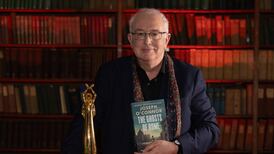Born: October 7th 1933
Died: June 18th 2025
There is a generation of Irish people who know exactly who Sally O’Brien was ... “and the way she might look at you”.
The same people likely felt an emotional connection to the equally memorable TV advertisement for Guinness – the one featuring a thatched cottage, a ticking clock the only sound breaking the silence until, cue aerial shot of a currach being rowed vigorously – a barrel of the black stuff is its cargo.
RM Block
A man rushes into the forlorn bar, announcing to the waiting, thirsty customers: “Tá siad ag teacht.” (They’re coming.) and the men rush to land the Guinness on a golden sandy beach.
Both ads played on distinctly Irish emotions – one on the emigrant’s yearning for home, the other on the widely shared image people have of the west of Ireland and of the Aran Islands idyll in particular.
And both were the creations of Frank Sheerin, a comedy scriptwriter and powerhouse of clever creativity in the Irish advertising industry of the 1970s and 1980s, who has died aged 91.
The Guinness 1977 advertisement, known simply as The Island, won a Clio Award, the adman’s Oscar, in New York the following year, as well as a silver Cannes Lion at the Advertising Awards Festival of Creativity in the French Riviera city. With perhaps understandable hyperbole, Ireland’s Marketing Magazine pronounced in 1999 that it was the “Ad of the century”.
The 1983 Harp Lager ad tapped into the grim reality of growing mass immigration spawned by domestic economic failure that blighted that decade.
“What I miss about home,” writes a young man sitting in what appears to be a desert, “is the rain and the greenness ... and the pint of Harp.”
Cue a pub scene, traditional music in the background and that longed-for look from you-know-who.
“Oh, the money is good,” writes the man, “and the suntan is free. You could fry an egg on the stones here. If you had an egg.”
Whatever about the fried egg, it was clear that our man’s deep longing, what really tugged his heartstrings, was the enigmatic glance from Sally O’Brien (British actress Vicki Michelle). She later found much wider fame as Yvette Carte-Blanche, the mildly risqué waitress in the BBC sit-com ‘Allo ‘Allo!, but, three decades later, she said: “It’s 30 years since I was Sally O’Brien but Irishmen still try to chat me up.”
Sally O’Brien’s creator, Frank Sheerin, was born in Dún Laoghaire in 1933, the youngest of four boys, to John and Eileen Sheerin. John Sheerin worked at West’s of Grafton Street but died when Frank was just four years old, leaving Eileen to raise the family alone. As a result, she moved with the children to Inchicore where she ran a small grocery shop.
Sheerin’s recollection of the second World War, which he wrote about in an unpublished family memoir covering his first seven years, included making his First Communion the day after the May 1941 German aerial bombing of Dublin’s North Strand in which 28 people died.
He went to school at St Michael’s in Inchicore and later on, Rockwell College in Co Tipperary. There, his creative and artistic side was evident: he acted in school plays and continued in the amateur dramatic scene into early adulthood.
Hopes of an acting career were dashed when Laurence Harvey beat him to land the role of Romeo in Renato Castellani’s 1954 production of Romeo and Juliet.
More conventionally, Sheerin hoped to get a job in Guinness’s, prized in the 1950s as secure employment for life, but was forced to settle for a start with Richie’s Sweets factory, where he was a clerk. At the same time, he attended night school at the College of Commerce in Rathmines, where he studied marketing and where his talent as a copywriter became evident.
An early break saw him land his first advertising job at Kenny’s of Middle Abbey Street, moving in the late 1950s to Arks, then on the cusp of a richly creative period. His contemporaries in the 1960s and 1970s included Bill Felton, Breandán O Broin, Phil Walsh, three Horslips – Barry Devlin, Eamon Carr and Charles O’Connor – Jimmy Strathern, Pat Ingoldsby, Terry Pattison and Catherine Donnelly.
Within the company, Sheerin was a success and, in 1967, he joined the board as creative director. He left eventually to set up his own company, Frank Sheerin Associates. He retired from advertising in the 2000s and was among the contributors to the 2009 RTÉ documentary, Ireland’s Mad Men.
He had a separate, though complementary, career in radio where, in partnership with Fergus Linehan, he co-wrote the comedy programme, Get An Earful of This, produced and directed by Willy Styles, which ran on RTÉ Radio 1 between 1967 and 1981.
He met his first wife, Anne, at a dance in Bray, Co Wicklow, and they married in 1957. They had three daughters together but separated later. Anne died in 2007.
He met his second wife, Catherine Donnelly, at Arks. Catherine too was a highly successful copywriter and well-regarded force throughout the advertising industry.
She created the Barry’s Tea, Christmas train set commercial and was also responsible for the slightly surreal Kerrygold ad in which the question is posed: “Who’s bringing the horse to France?”
In retirement, they moved to Roscrea and, after Catherine’s death in 2014, Frank moved back to Dublin where, in a Sandymount care home, he died in June.
In tributes from friends and former colleagues posted on RIP.ie, he was remembered as an intelligent, witty, creative, and inspiring man with an easy manner who created enormous amounts of fun.
Frank Sheerin is survived by his daughters Bláithín, Róisín and Maureen, and by his two grandchildren.


















